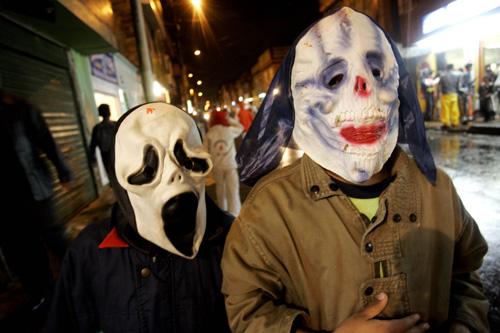Poll: Fewer minority children trick-or-treat

Two children dressed in costume to celebrate Halloween walks as they collect candies through a neighborhood of Bogota, Colombia, Tuesday, Oct. 31, 2006. Two-thirds of parents say their children will trick-or-treat this Halloween. The Associated Press
Oct 29, 2007
Last updated on May 12, 2016 at 05:53 p.m.
WASHINGTON – Two-thirds of parents say their children will trick-or-treat this Halloween, but fewer minorities will let their kids go door to door, with some citing safety worries, a poll shows.
The survey found that 73 percent of whites versus 56 percent of minorities said their children will trick-or-treat on Wednesday.
That disparity in the survey is similar to the difference in how people view the safety of their neighborhoods, according to the poll by The Associated Press and Ipsos. Lower-income people and minorities are more likely to worry that it might not be safe to send their children out on Halloween night.
Thomas Link, 50, and his family are new to their trailer park in Palatka, Fla. He said he considers it unsafe because he does not know many neighbors, but had not decided whether to let his three young children trick-or-treat.
Get The Daily Illini in your inbox!
“I’m very particular about who I let my kids deal with,” he said.
Overall, 86 percent of those questioned in the survey said their neighborhoods are safe for trick-or-treating. Ninety-one percent of whites, compared with 75 percent of minorities, said they felt their kids would be secure when they went out seeking candy in their area.
Similarly, 93 percent of people earning $50,000 or more said their communities are safe for trick-or-treating, compared with 76 percent of those making less than $25,000.
Even many people who view their neighborhoods as safe take precautions.
Kristi Nichols, 35, of Seaford, Del., who said she lives in the community where she grew up, accompanies her children on their Halloween rounds.
“I’m a forensic nurse and I know what happens,” she said. “It’s very different from when I was little.”
Nearly two-thirds of the people in the survey said their households will distribute Halloween treats to children who come to call; the likeliest to pass out goodies include younger and higher-earning people.
Seventy percent of people in the poll who consider themselves liberals and 67 percent of the moderates questioned said they would hand out treats, compared with 55 percent of conservatives.
Of those adults whose children will not trick-or-treat this year, one-quarter cited safety worries and about one-half said they do not celebrate Halloween.
“It’s demonic,” said Donna Stitt, 37, a nursing aide from Barto, Pa., with four young children. “People are celebrating the dead. I’m not into that.”
Last October, a Gallup Poll found 11 percent said they do not celebrate Halloween for religious reasons.
AP Director of Surveys Trevor Tompson and AP News survey specialist Dennis Junius contributed to this report





